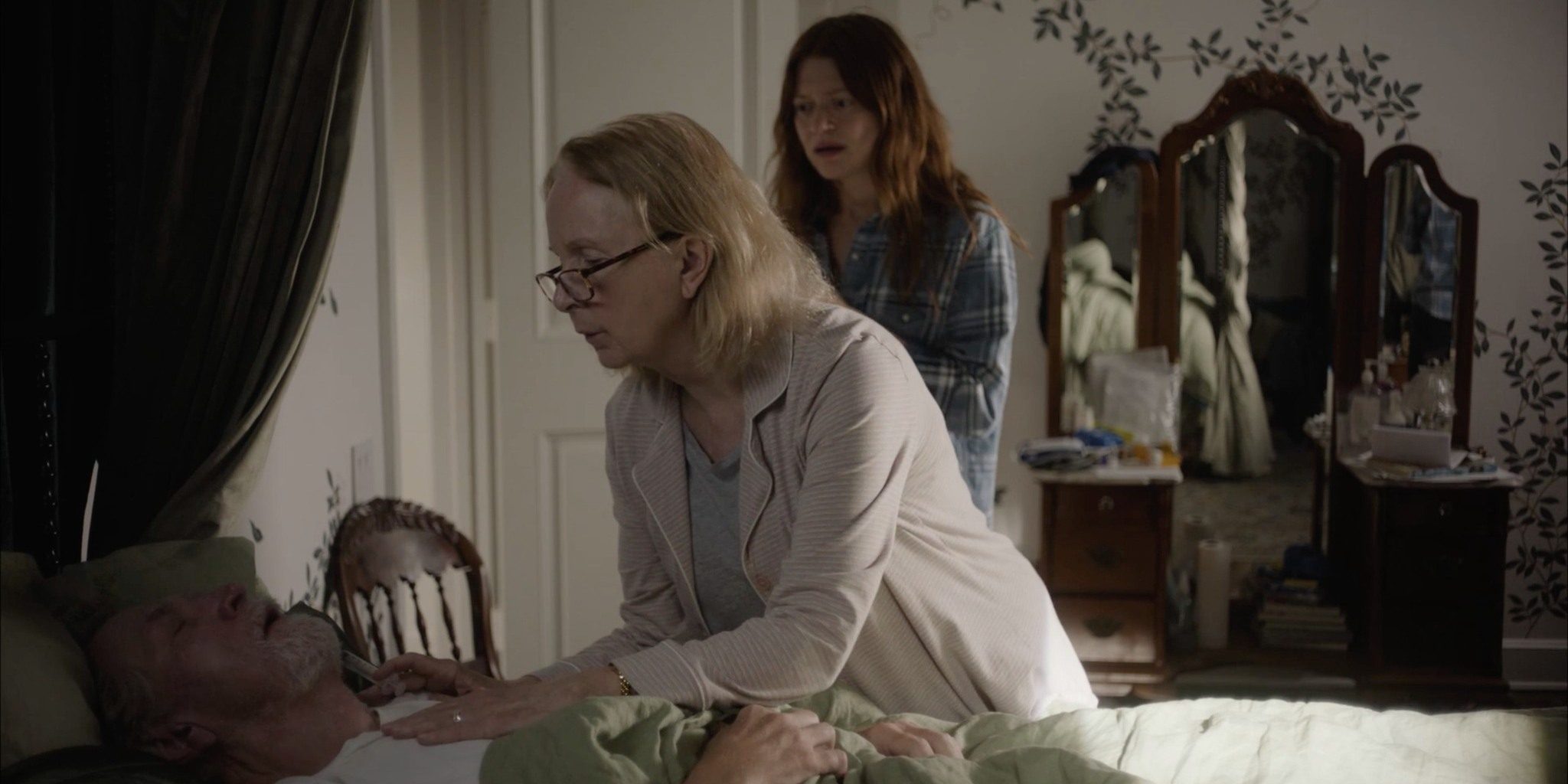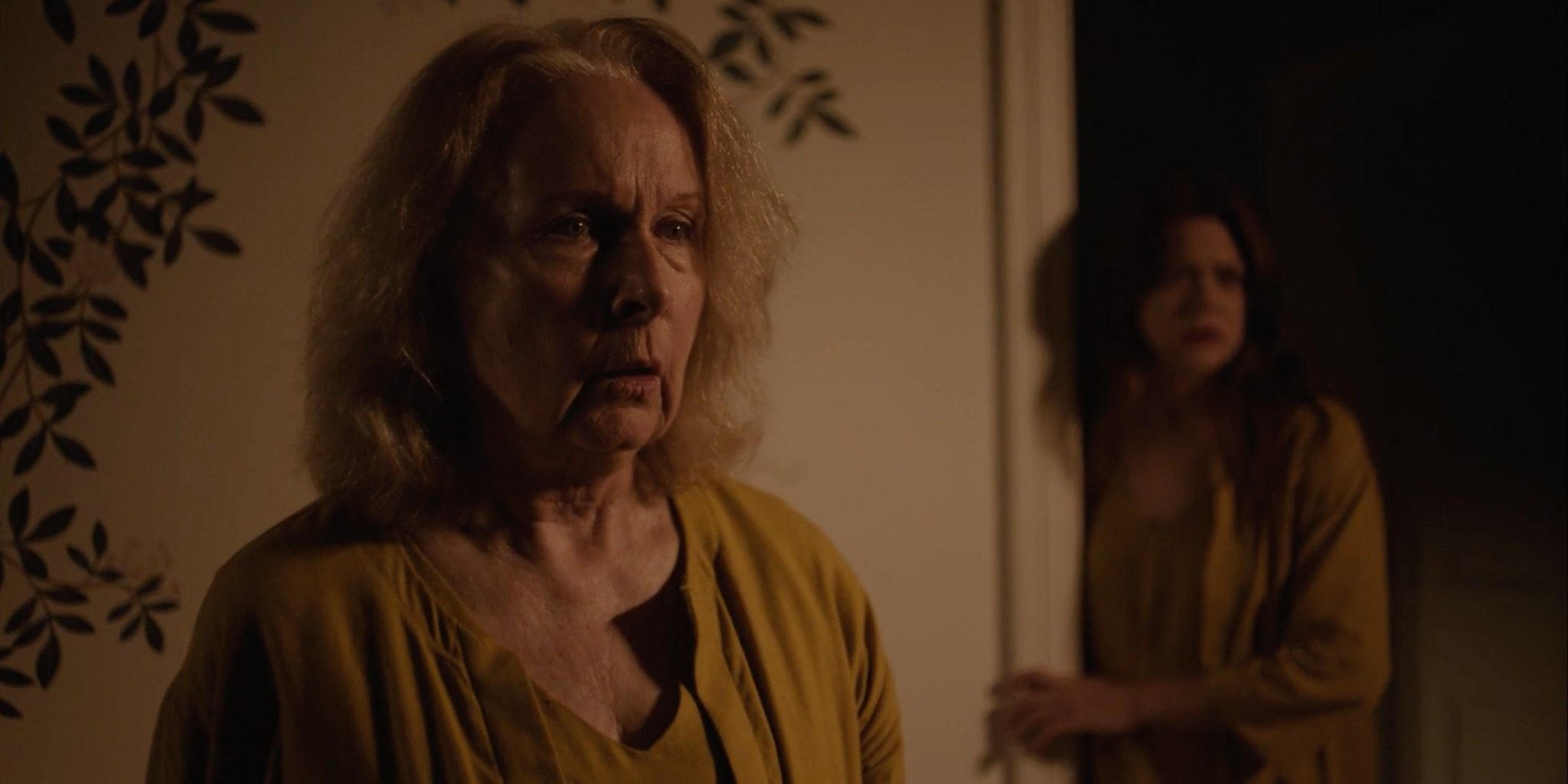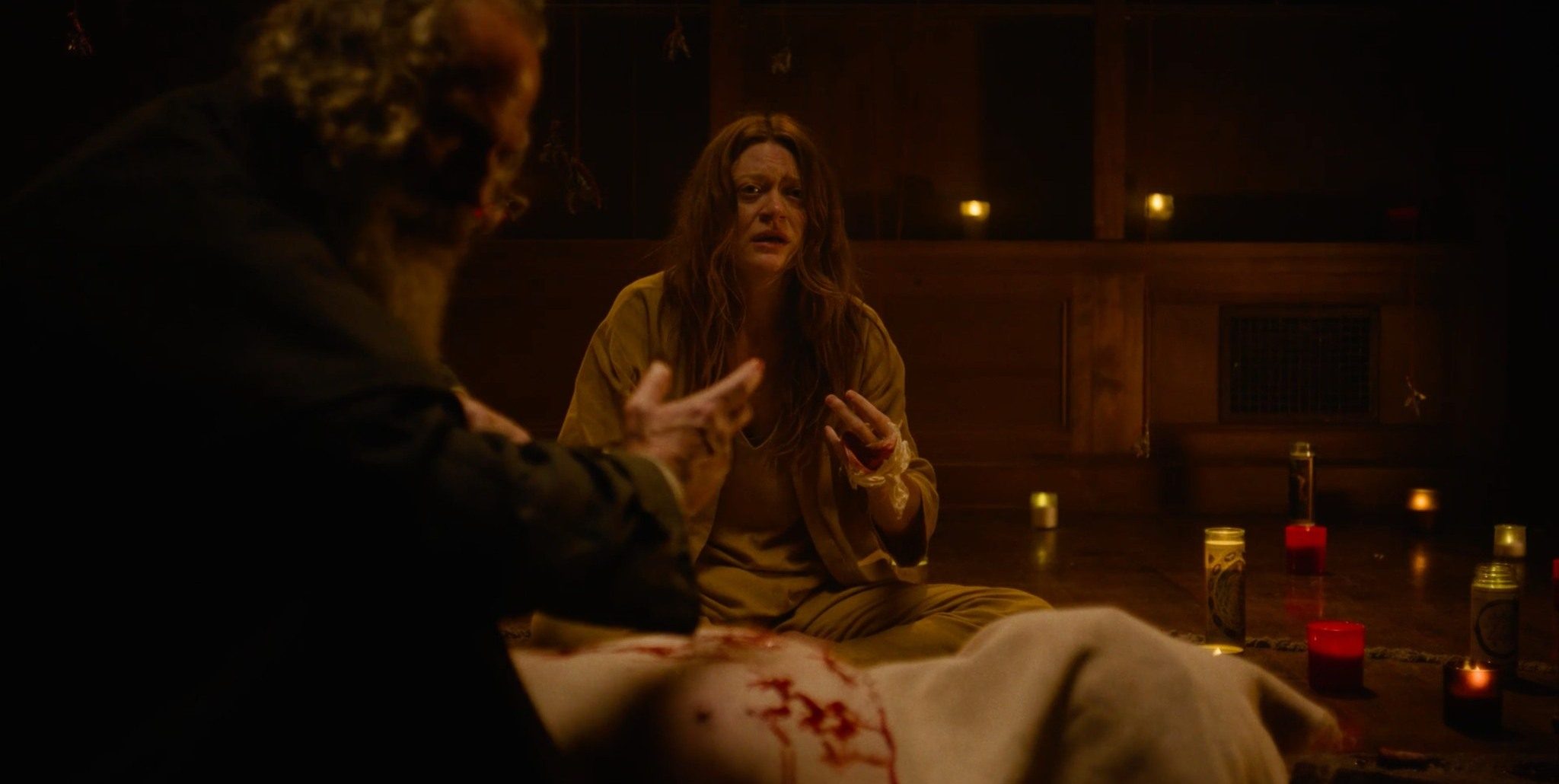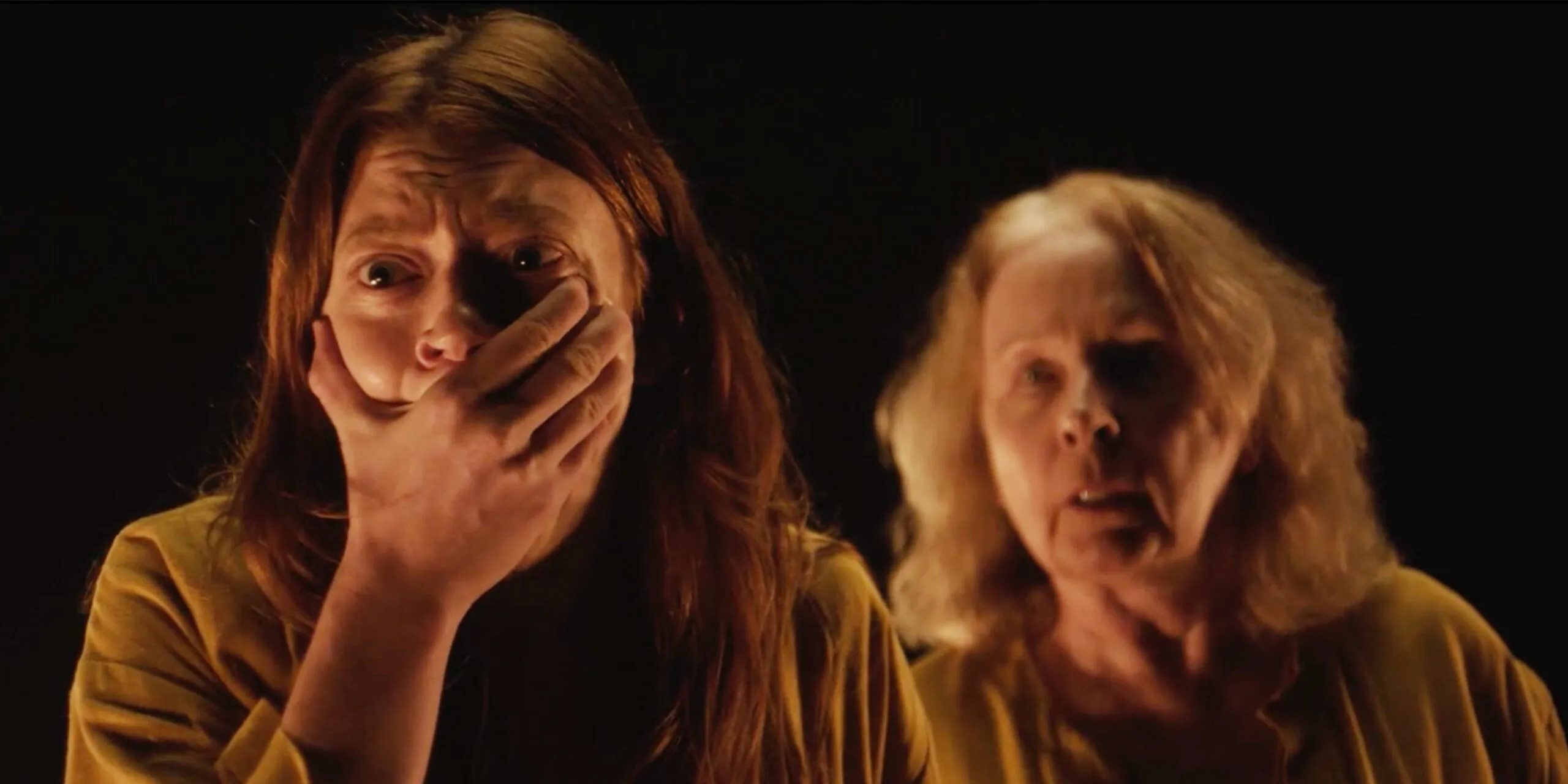Julia Max’s ‘The Surrender’ ends on a somewhat cryptic note as we witness the consequences of grief, tragedy, and the sunk cost fallacy manifest themselves through Barbara and Megan’s fraught mother-daughter relationship. After struggling to make Barbara see reason, the final parts of the film center on Megan coming to terms with her terrifying predicament as she confronts the sheer weight of isolation on her shoulders, especially after the ritual to bring her father back takes a demented twist. With dread clouding her senses, the protagonist must navigate the ritual’s intricacies, including the pivotal stages of surrender she must go through to escape her prison. However, despite her efforts, the film’s ambiguous ending throws uncertainty over the fate of our main character and the central thematic meaning. SPOILERS AHEAD.
The Surrender Plot Synopsis
The movie begins with a terrifying vision of a disfigured human being with scars, bruises, and fissures feasting on another human carcass. As the screen fades to black, we shift our attention to a small suburban house where an aging old man named Robert lies on his bed while his wife, Barbara, and daughter, Megan, take care of his needs. It becomes evident that Robert has been suffering for a long time, a situation that has only been exacerbated by Barbara’s desire to control every aspect of his treatment. When a nurse stops by the house, we learn that Barbara has been administering half the prescribed morphine dosage to keep him dependent on her. As such, the dysfunctional elements of the family constantly rear their heads whenever Megan confronts her mother about her irrationality and selfishness.

Worried that her mother is losing herself in the process of caring for Robert, Megan suggests taking a break, an idea that Barbara vehemently opposes. She fears that Robert might need her at any moment, something that has become intrinsically linked with her identity. However, Megan convinces Barbara to step out of the house for a few hours while she takes over prime nursing duties. As the night progresses, we learn that Barbara lies about going out and spends her time cooped up in her car outside the house’s premises. She beads parts of her torn hair into a rather eerie necklace that resembles some protection charm. In the meantime, things inside the house become tense as Megan hears faint scratching noises within the walls, including reliving memories of her father’s younger years.
When Robert starts to act up in his sleep, Megan freaks out and decides to administer his morphine before his scheduled time. She gives him the full prescribed dosage and notices him acting frantically. After putting him to bed, she is greeted by her mother, who accidentally administers another dose of morphine, believing that Megan missed her time slot. However, with the double dosage of morphine in his bloodstream, both mother and daughter grow concerned over what might happen next. Their queries are answered the following night when they discover Robert has passed away in his sleep. Although Megan is sad, she is thankful that the family’s trying period is over. Unfortunately, the same isn’t the case with her mother, who convinces Megan that Robert can be brought back via a resurrection ritual, which is the start of their troubles.
The Surrender Ending: Does Megan Escape the Circle?
After learning that Barbara wants to bring Robert back to life, Megan tries to tell her mother that the idea of reviving a dead person is a complete departure from the world of common sense. However, Barbara is too far gone in her beliefs to listen to reason, forcing Megan to support her through the ordeal. Soon, a strange man visits the home, invited by Barbara to carry out the ritual aimed at resurrecting Robert. Although Megan is unnerved by his presence, she learns that the entire process of resurrection involves three surrenders. In layman’s terms, Megan and Barbara must surrender parts of themselves to get Robert back. It immediately sets the precedent for something going wrong terribly, which is precisely what transpires.

Following the completion of the protection circle, the man begins the ritual to revive Robert. At first, the trio are transported into a netherworld where spirits and souls inhabit dead objects and people. Robert’s corpse disappears, seemingly gaining agency after some demon takes over the body’s faculties. At the same time, Barbara and Megan realize that the man’s jaw has been torn to pieces, indicating that the protection circle is not working as planned. The reason for this is tied to Megan keeping a photograph of her dad, which she should have burned as per the instructions. Fortunately, mother and daughter burn the picture in time to complete the circle, staving any further incursions from Robert’s dead body. However, while they might be safe for now, they have no way to return to the land of the living.
The man is killed by Robert, leaving Barbara and Megan stranded inside the circle. Eventually, even Barbara falls prey to the forces lurking outside the circle, meaning only Megan survives. She spends her time reeling inside the circle, wondering how she might be able to return to Earth. She even sacrifices more of her fingers as a way to trigger the third surrender, which is meant to return her home. However, no breakthrough takes place until the very end, when Megan seemingly blows a hole open in the protection circle, an act that immediately triggers a flash of blinding light over proceedings. It is highly reminiscent of the light that shines over the circle when they are transported to the netherworld in the first place. While the exact mechanics are vague, it could be a sign that her third surrender is complete, allowing her to return home.
One of the reasons why the breaking of the circle can be considered as a third surrender is because it shows the individual within is willing to give up their life. While the second surrender is mostly related to the losing of body parts, case in point, the severing of Megan and Barbara’s fingers, the third must ramp up the ante even further to complete the process. To that end, it makes sense that the final surrender involves an act of self-sacrifice, surrendering oneself to the great, overwhelming, and terrifying forces waiting outside the circle. In some ways, it serves as a metaphor for the grief engulfing the central characters and how they are afraid of giving in to it. In the end, Megan finds her solace by finally accepting the loss as part of her life, which is likely personified as the third surrender, offering her the chance to rebuild her life once more.
What Happens to Barbara?
While Megan’s fate is left somewhat ambiguous, the same cannot be said for Barbara, whose desperate need to revive her husband leads her to a seemingly painful end. In the final moments, we witness her being yanked out of the circle by Robert’s demon-possessed body and dragged towards the shadows. Although we have no confirmation of what happens to her in the dark, she is likely killed/eaten by Robert in a gruesome manner. She later surfaces as a demon herself when she steps in front of Megan, providing concrete evidence that she died. Tragically, her fate may have been avoided if she had exercised a slight degree of caution. However, considering how paranoid and desperate she becomes for Robert’s well-being and revival in the story, that feels ridiculous.

It is undeniable that much of the dark events that take place in ‘The Surrender’ are both directly and indirectly influenced by Barbara. Because she is obsessed with taking care of Robert and exerting control over every aspect of her family life, she becomes prone to a series of bad decisions that can only be characterized as the effects of the sunk cost fallacy. She devotes so much effort, energy, time, and money to her husband’s day-to-day treatment and well-being that she becomes convinced that his recovery is imminent. To that end, she constantly pushes herself, believing that there is light at the end of the tunnel no matter how bleak the present circumstances might be. However, she does not account for the fact that sometimes things do not work out, even if good intentions and hard work fuel those actions.
When Robert passes away, Barbara sees it as a minor inconvenience in her road to curing her husband. It is a complete and total corruption/perversion of the notion of mortality, which prevents Barbara from seeing things clearly. Thus, while it may be easy to judge her actions as those of a depraved mind and someone who cannot separate her selfish desires from the greater good, it also showcases her human and fallible nature. This is especially true when cases of tragedy and the loss of a loved one are involved. At the end of the narrative, we witness Megan making peace with her mother’s empty husk, plainly admitting that even though she always hated her many personality traits, she ultimately loved her nonetheless. In a strange way, this love allows Megan to free herself as she finally sees Barbara for the flawed but beautiful human being she is.
Why Does Megan See Old Memories of Her Parents? What Do They Mean?
An intriguing aspect of ‘The Surrender’ is how it carefully laces a lot of childhood memories belonging to Megan amidst its larger narrative. More often than not, these memories center on Megan’s exchanges with her dad and general conversations between him and his wife. They showcase the differences between their younger and present-day selves, illustrating the gap that has opened up in the intervening years. They raise questions about how a seemingly ideal bond becomes fraught with darkness and despair. However, as Megan discovers later, this is only because she idolizes her dad while considering her mother the root of all her problems. In fact, the more she probes through her memories, the more it becomes clear that things were never as cut and dry as she remembers.

In various instances, Megan discovers that her mother was the one fighting for her side while her father was vehemently opposed to a lot of things. She finds it hard to believe that Robert was anything but kind to her growing up. However, the opposite seems to be the case because Barbara had to curb Robert’s darker tendencies and his often traditional/orthodox views on women and girls. This even extends to his daughter, which is depicted in the memory where she sees Robert stopping her from participating in any more dance classes from the age of seven. These memories are Megan’s first realization that she has wrongly vilified her mom when the situation is more complicated. She admits this near the end, learning the reality hidden beneath most relationships.
It is worth noting that the memories likely have some root in the symbological aspects of the narrative. It may be a metaphor for how these memories are her only ties to them, causing even more grief once they pass away. As grief is a central aspect of ‘The Surrender,’ it makes sense that Megan’s memories of her parents are her only attachment to her father once he passes away. Without them, she has no sense of identity or connection to her dad. Yet, those memories also become the source of great pain when Robert passes away, showing the duality of remembrance and how it can be both a boon and a curse in equal measure. The more Megan tries to cling to her memories, the more she suffers from her father’s death. Only when she willingly lets it go can she free herself from the entangled roots of familial love, belonging, and the pain of those things being ripped apart.
Read More: Frewaka Ending Explained: Is Shoo Dreaming?


